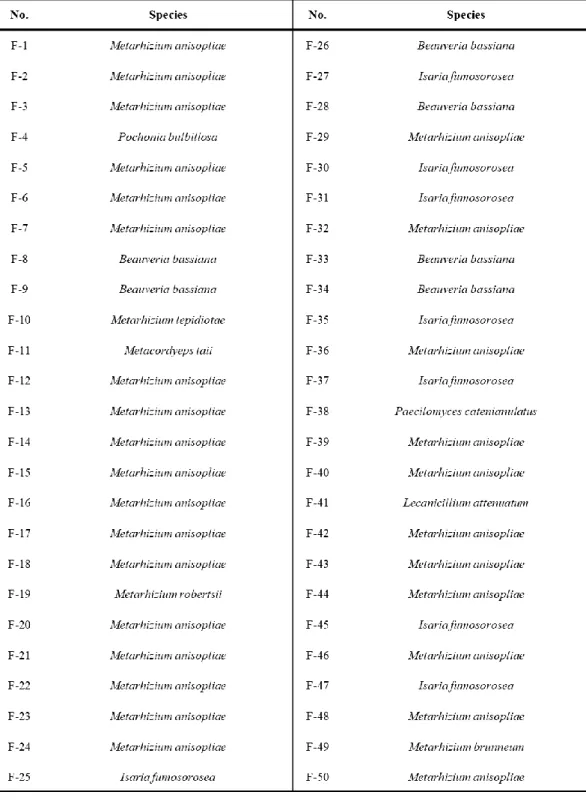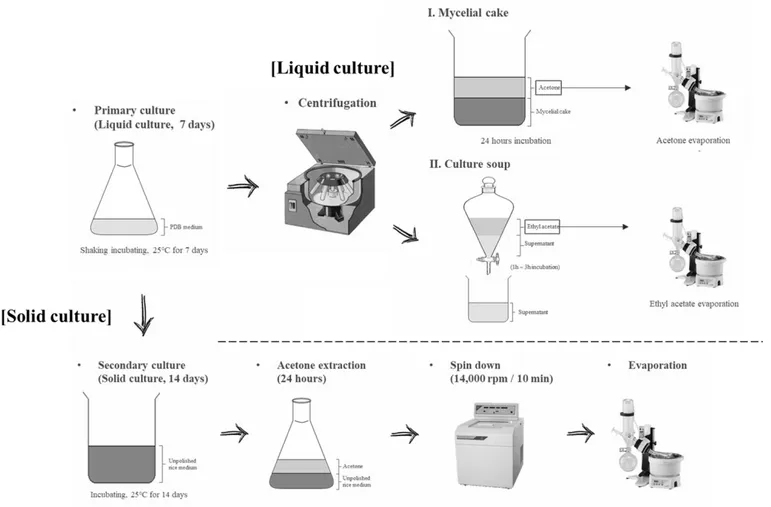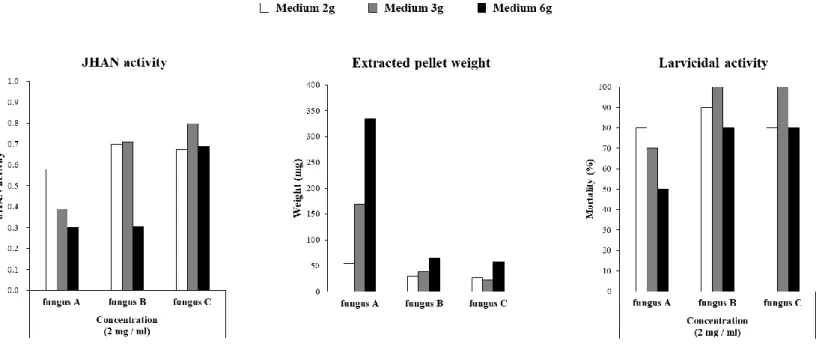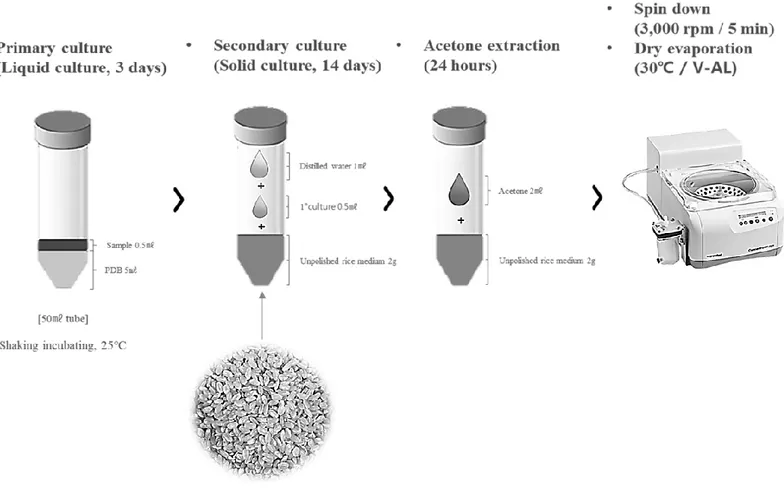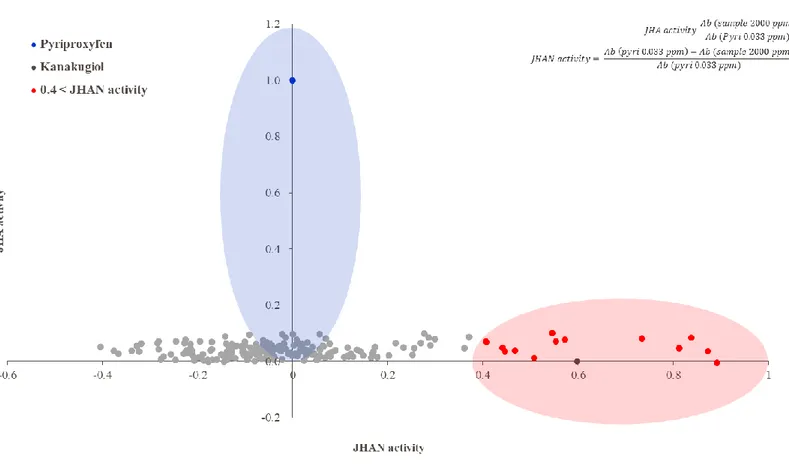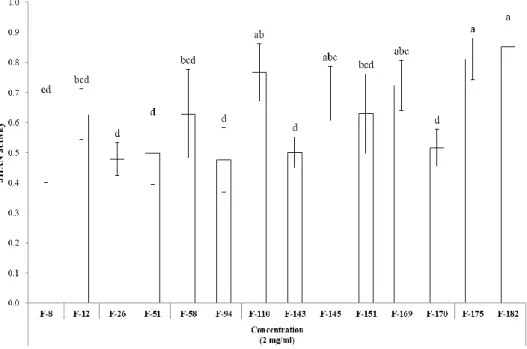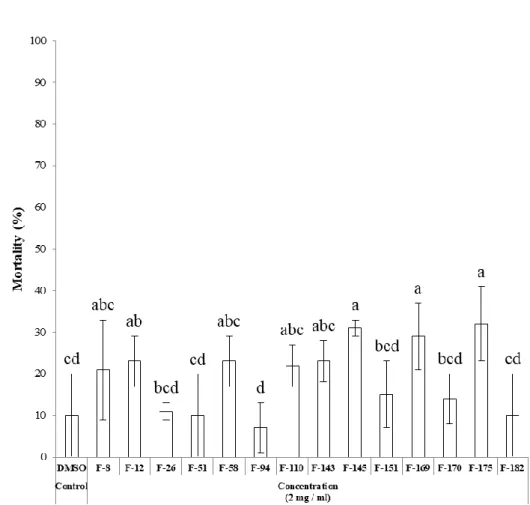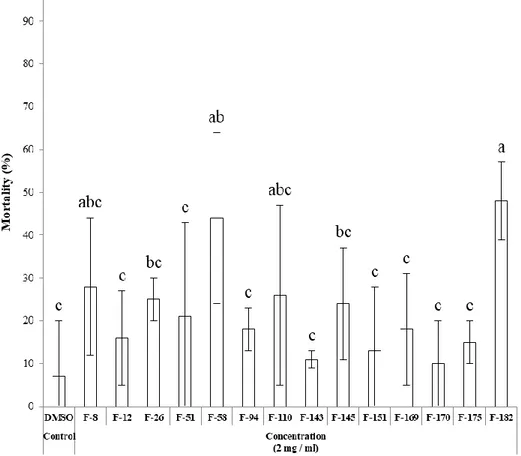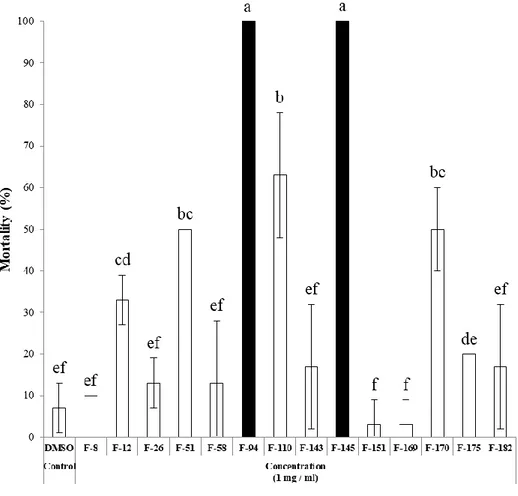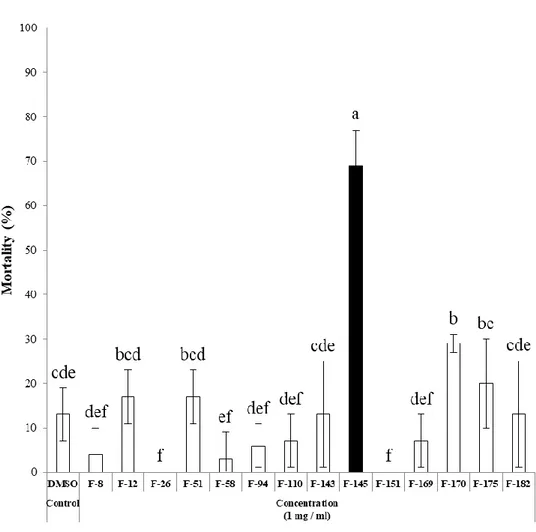저작자표시-비영리-변경금지 2.0 대한민국 이용자는 아래의 조건을 따르는 경우에 한하여 자유롭게 l 이 저작물을 복제, 배포, 전송, 전시, 공연 및 방송할 수 있습니다. 다음과 같은 조건을 따라야 합니다: l 귀하는, 이 저작물의 재이용이나 배포의 경우, 이 저작물에 적용된 이용허락조건 을 명확하게 나타내어야 합니다. l 저작권자로부터 별도의 허가를 받으면 이러한 조건들은 적용되지 않습니다. 저작권법에 따른 이용자의 권리는 위의 내용에 의하여 영향을 받지 않습니다. 이것은 이용허락규약(Legal Code)을 이해하기 쉽게 요약한 것입니다. Disclaimer 저작자표시. 귀하는 원저작자를 표시하여야 합니다. 비영리. 귀하는 이 저작물을 영리 목적으로 이용할 수 없습니다. 변경금지. 귀하는 이 저작물을 개작, 변형 또는 가공할 수 없습니다.
A THESIS
FOR THE DEGREE OF MASTER OF SCIENCE
Identification and Characterization of Entomopathogenic Fungi
Producing Insect Juvenile Hormone Antagonist
곤충 유약호르몬 길항제를 생산하는
곤충병원성 곰팡이의 선별 및 특성 구명
By
Ra Mi Woo
Major in Entomology
Department of Agricultural Biotechnology
Seoul National University
Identification and Characterization of Entomopathogenic Fungi
Producing Insect Juvenile Hormone Antagonist
곤충 유약호르몬 길항제를 생산하는
곤충병원성 곰팡이의 선별 및 특성 구명
UNDER THE DIRECTION OF ADVISER YEON HO JE
SUBMITTED TO THE FACULTY OF THE GRADUATE SCHOOL OF SEOUL NATIONAL UNIVERSITY
By
Ra Mi Woo
Major in Entomology
Department of Agricultural Biotechnology
Seoul National University
August, 2019
APPROVED AS A QUALIFIED THESIS OF Ra Mi Woo
FOR THE DEGREE OF MASTER OF SCIENCE
BY THE COMMITTEE MEMBERS
CHAIRMAN Si Hyeock Lee _________________________
VICE CHAIRMAN Kwang Pum Lee _________________________
MEMBER Yeon Ho Je _________________________
II
Identification and Characterization of Entomopathogenic Fungi
Producing Insect Juvenile Hormone Antagonist
Major in Entomology
Department of Agricultural Biotechnology
Seoul National University
August 2019
Ra Mi Woo
ABSTRACT
Insects not only cause great economic damages to agricultural products, but also pose threats to human health by transmitting various diseases. In general, chemical insecticides have been used to control insect pests. As chemical insecticides have disadvantages such as toxicity to environments and insect resistance, needs for eco-friendly insecticides are on the rise. Insect growth regulators (IGRs) could become an effective alternative to conventional chemical insecticides because they are specific to target insects and have a low toxicity to non-target organisms. Entomopathogenic fungi are an important natural
III
pathogen of insects and have been developed as biological control agents for many important agricultural, forest and medical pests. These fungi produce a wide range of secondary metabolites such as antibiotics, pesticides, growth-promoting or inhibiting compounds, insect attracting agents and antifreeze agents. In this study, to explore novel IGR substances from entomopathogenic fungi, culture extracts of 189 entomopathogenic fungi isolated from Korean soil samples were investigated for their juvenile hormone (JH)-based IGR activities. Whereas none of the culture extracts exhibited JH agonist (JHA) activity, 14 extracts showed high levels of JH antagonist (JHAN) activity. Among them, culture extract of F-145 strain, which was identified as Lecanicillium attenuatum, showed the highest insecticidal against 3rd instar larvae of Aedes albopictus and Plutella
xylostella. At liquid culture condition, JHAN activity was observed in culture soup rather
than mycelial cake, suggesting that the substances with JHAN activity are released from the F-145 strain during culture. Furthermore, while extract from solid cultured F-145 strain showed insecticidal activities against both A. albopictus and P. xylostella, that from liquid cultured fungi showed insecticidal activity only against A. albopictus. These results suggested that L. attenuatum F-145 strain produces different kinds of secondary metabolites depending on culture conditions.
Key words: Entomopathogenic fungi, Lecanicillium attenuatum, insect growth regulator, Juvenile hormone antagonist, Aedes albopictus, Plutella xylostella
IV
TABLE OF CONTENTS
ABSTRACT ... II
TABLE OF CONTENTS ... IV
LIST OF TABLES ... VI
LIST OF FIGURES ... VII
INTRODUCTION ... 1
LITERATURE REVIEW ... 3
1.
Entomopathogenic fungi ... 3
2.
Juvenile hormone ... 5
3.
Insect growth regulator (IGR) ... 7
METERIAL AND METHODS ... 10
1.
Insects ... 10
2.
Entomopathogenic fungi ... 10
3.
Yeast two-hybrid β-galactosidase assay ... 15
4.
Yeast growth inhibition tests ... 16
5.
Insect bioassay ... 16
V
7.
Morphological identification of selected fungal strain ... 19
8.
Molecular identification of selected fungal strain ... 19
RESULTS ... 21
1.
Establishment of high-throughput culture condition ... 21
2.
JHA and JHAN activities of entomopathogenic fungal extracs ... 24
3.
Insecticidal activity of entomopathogenic fungal extracs with
JHAN activity ... 27
1.
Taxonomic identification of the F-145 strain ... 32
2.
Larvicidal activities of the F-145 extract against A. albopictus ... 36
3.
Activity of the F-145 extract according to culture conditions ... 39
DISCUSSION ... 44
LITERATURES CITED ... 47
VI
LIST OF TABLES
Table 1. List of entomopathogenic fungal strains used in this study. ... 11 Table 2. Median lethal concentration (LC50) of the F-145 extract against 3rd instar larvae of A.
VII
LIST OF FIGURES
Figure 1. Liquid and solid culture conditions of selected entomopathogenic fungi. ... 18
Figure 2. JHAN activity (left), extracted pellet weight (middle), and larvicidal activity (right) of extract from entomopathogenic fungi cultured on different aerobic conditions. ... 22
Figure 3. High-throughput culture condition of entomopathogenic fungi strains. ... 23
Figure 4. Screening of entomopathogenic fungi for their IGR activites. ... 25
Figure 5. JHAN activity of entomopathogenic fungal extracts ... 26
Figure 6. Insecticidal activity of entomopathogenic fungal extracts against O. furnacalis ... 28
Figure 7. Insecticidal activity of entomopathogenic fungal extracts against L. striatellus ... 29
Figure 8. Insecticidal activity of entomopathogenic fungal extracts against A. albopictus ... 30
Figure 9. Insecticidal activity of entomopathogenic fungal extracts against P. xylostella ... 31
Figure 10. Morphological characteristics of the F-145 strain ... 33
Figure 11. Scanning electron micrographs of conidia produced by the F-145 strain. .... 34
Figure 12. Phylogenetic relationship of the F-145 strain based on nucleotide sequence of ITS region ... 35
VIII
Figure 14. JHA activity of F-145 extracts from solid and liquid cultures ... 40 Figure 15. JHAN activity of F-145 extracts from solid and liquid cultures ... 41 Figure 16. Insecticidal activity of F-145 extracts from solid and liquid cultures against A.
albopictus ... 42
Figure 17. Insecticidal activity of F-145 extracts from solid and liquid cultures against P.
1
INTRODUCTION
Insects are the greatest populations on Earth and form the largest group of fauna in the world. These insects serve as a host or a nutrition source for various parasites, pathogens and predators such as bacteria, fungi and viruses (Molnar, Gibson, & Krasnoff, 2010). It is increasingly recognized that the biodiversity in agricultural ecosystem deliver important ecosystem services to agricultural production such as biological control of pests (Meyling & Eilenberg, 2007).
Over the past 50 years, research into insect pathogenic fungi has begun with an understanding of the role of natural phenomena in the regulation of insect populations. Entomopathogenic fungi are a fungus that controls the density of host insects by cause fungal disease. These fungi, like other insect pathogenic microorganisms, have been reported to be pathogenic only to target pests and generally have no toxicity to the environment and animals (Lacey, Frutos, Kaya, & Vail, 2001). Entomopathogenic fungi are known to more than 700 species of 100 genera by continuous separation and reporting (Frenando E Vega, Meyling, Luangsa-ard, & Blackwell, 2012). Entomopathogenic fungi secrete a variety of enzymes, protein toxins and secondary metabolites as well as physical forces by mycelium growth during the process of host invasion and proliferation (Isaka, Kittakoop, Kirtikara, Hywel-Jones, & Thebtaranonth, 2005).
Insect growth regulator (IRG) interrupts the normal growth, development and reproduction of insects. IGRs are attractive alternatives to conventional chemical insecticides because they are specific to target insects and have a low toxicity to non-target organisms (Beckage, Rechcigl, & Rechcigl, 2000). IGRs are classified to juvenile
2
hormone agonist (JHA), ecdysone agonist (EA) and chitin synthesis inhibitors (CSI) according to their mode of action (Pener & Dhadialla, 2012). Recently, a novel type of IGR, juvenile hormone antagonists (JHANs), have been identified using a yeast two-hybrid system transformed with the Aedes aegypti juvenile hormone (JH) receptors, methoprene-tolerant (Met) and Ftz-F1-interacting steroid receptor coactivator (FISC) (S.-H. Lee et al., 2015). These JHANs directly disrupt the JH-mediated interaction between the Met and its binding partners, FISC or Cycle (CYC), in the mosquito A. aegypti (S.-H. Lee et al., 2015). Both JHAs and JHANs cause abnormal development and larval death not only by interfering with metamorphosis but also by disturbing normal embryonic development because JH regulates development, reproduction, diapause and many other aspects of insect physiology (S.-H. Lee et al., 2015; Slama, 1971). Using this method, various kinds of JHA and JHAN active substances have been reported from the secondary metabolites of plants and actinomyces, as well as chemical library (S.-H. Lee, K. B. Ha, et al., 2018; S.-H. Lee, H. N. Lim, et al., 2018; S.-H. Lee et al., 2015; S. H. Lee et al., 2018). Entomopathogenic fungi also produce a variety of secondary metabolites, like plants and actinomyces. As various biological activities including antibacterial, anti-cancer and insecticidal activities have been reported from secondary metabolites of entomopathogenic fungi, it was assumed that entomopathogenic fungi could be potential sources IGR substances, such as JHA or JHAN.
In this study, in order to explore novel IGR substances from entomopathogenic fungi, high-throughput culture conditions for effective screening of large quantities of fungi were established. After investigating JHA and JHAN activities, fungal strains showing high JHAN activity were selected and their characteristics were investigated.
3
LITERATURE REVIEW
1. Entomopathogenic fungi
Entomopathogenic fungi is to control the density of host insects in nature by fungal disease for using ecological nutrient (Brownbridge, Humber, Parker, & Skinner, 1993; Roy et al., 2010). The first record of fungi causing insect disease, Beauveria bassiana is the first to cause disease in silkworm (Bombyx mori) recorded by Italian entomologist Agostino Bassi in 1835 (S.-Y. Lee, Nakajima, Ihara, Kinoshita, & Nihira, 2005; Rehener & Buckley, 2005).Fungi that cause disease in insects are all recognized as entomopathogenic fungi of the teleomorph or the anamorph and accepted that there is an interrelationship (Rehener & Buckley, 2005; Sung et al., 2007; Sung, Poinar Jr, & Spatafora, 2008; Frenando E Vega et al., 2012). Entomopathogenic fungi are known to more than 700 species of 100 genera by continuous separation and reporting (Spatafora, Sung, & Kepler, 2010; Sung et al., 2007).
Unlike bacteria and viruses that are transmitted through feeding, entomopathogenic fungi can infect insects not only through the gut, but also through spiracles and particularly through the surface of the integument (Frenando E Vega et al., 2012; Wang & Leger, 2007). After the spores germinated on the epidemics, they secrete various enzymes, penetrate the cuticle and reach in hemocoel. At this time, over 100 different genes are found to be used to penetrate each cuticle layer (Fang, Azimzadeh, & Leger, 2012). The fungus that reaches the hemocoel is rapidly proliferated using abundant nutrients in the hemolymph, it also secretes secondary metabolites that are toxic to host insect, it
4
eventually obliterates the host and produces a large number of spores on the surface of the host insect that could be a secondary source of infection. They will continue to live with other insects (Frenando E Vega et al., 2012). Currently, research on entomopathogenic fungi focuses on various enzymes and secondary metabolites produced during invasions and proliferation, in addition to viewing fungi as alternatives to pesticides. There is also a new type of control source for pest or microbial control using materials produced by fungi and an applied study for medicinal purposes. Entomopathogenic fungi, therefore, are increasingly recognized as an important fungi resource that can be used in many other studies (de Souza Santos et al., 2013; Ownley, Gwinn, & Vega, 2010; Schmidt et al., 2003; Sowjanya Sree, Padmaja, & Murthy, 2008; Fernando E Vega et al., 2009; Zhu, Halpern, & Jones, 1998).
Entomopathogenic fungi, such as other entomopathogenic microorganisms, have been reported to be pathogenic only to target pests and generally have no toxicity to the environment and other animals. So, major entomopathogenic fungi have been studied in large numbers as an alternative to biological or eco-friendly control of resistant pests and heating agents, which are difficult to prevent due to chemical agent (Lacey et al., 2001; Shah & Pell, 2003). For the development of fungal insecticide, the selection of enotmopathogenic fungi having pathogenicity and virulence against the target pests is first important, followed by mass production and decontamination (Frenando E Vega et al., 2012).
5
2. Juvenile hormone
It has been almost two centuries since studies relating juvenile hormone (JH) were started. Müller (Vizioli et al., 2000) described specific organs in the cockroach which were renamed as the corpora allata (CA) in 1899. However, until then, the CA was described as sympathetic ganglia concerned with the innervation of the digestive system. Although Police (1910) suggested that the CA is endocrine organs concerned with nervous function, it had remained to be proved that. In 1934, Wigglesworth (1934) began historical studies on insect JH, making efficient use of surgical techniques. He assumed at first that the CA is the source of the molting hormone, an “inhibitory factor” which prevents the first four larval stages from molting directly into adults in Rhodnius. In 1936, he showed that the CA is the source of the inhibitory hormone that prevents metamorphosis in young larvae and that the CA from young larvae when implanted into fifth instars caused them to undergo a supernumerary molt (V. B. Wigglesworth, 1936). Wigglesworth concluded that the concentration of the inhibitory hormone from CA determines the extent of metamorphosis at the next molt. Then, there have been many studies on JH function. The modern era of JH research began with the critical finding by Carroll Williams (1956) that he discovered a natural repository for juvenile hormone, “golden oil”, and JH was extracted and diluted in peanut oil or mineral oil to conduct hundreds or even thousands of experiments from male Hyalophora cecropia. About 10 years after, the structure of JH was identified using gas chromatographic analysis. Röller and colleague (Röller, Dahm, Sweely, & Trost, 1967) identified the first juvenile hormone from lipid extracts of the wild silk moth, H. cecropia. This JH, methyl (2E, 6E, 10cis) -10,11-epoxy-7-ethyl-3,11-dimethyl-2,6-tridecadienoate, was termed cecropia JH or C18
6
JH in older literature, but it is now recognized as JH I. Meyer (Meyer, Schneiderman, Hanzmann, & Ko, 1968) identified a minor component that is called JH II, which differed from JH I by a methyl group at C7 in the H. cecropia extracts. A third JH homologue, JH III, methyl 10,11–epoxy–farnesoate, was identified from media in which the CA of the tobacco hornworm, Manduca sexta, had been contained (Judy et al., 1973). JH III differs from the other homologues in that all three branches of the carbon skeleton, at C3, C7, and C11, are methyl groups. JH III appears to be the most common homologue among the species studied (Schooley, Baker, Tsai, Miller, & Jamieson, 1984). The trihomosesquiterpenoids JH 0 and its isomer 4–methyl JH I (iso–JH 0) were identified in
M. sexta eggs (Bergot, Schooley, & De Kort, 1981), but nothing is currently known of
their functions. JH III bisepoxy (JHB3) was identified from in vitro cultures of larval ring glands of Drosophila melanogaster (Richard, Applebaum, & Gilbert, 1989). These historical studies formed the basis of many JH-related studies today. JHs are a group of acyclic sesquiterpenoids that secreted from endocrine glands called CA. Main role of JHs were first recognized and described by Wigglesworth in the blood sucking bug, Rhodnius
prolixus (V. B. Wigglesworth, 1934). JHs roles mainly in various physiological functions
including molting, metamorphosis, reproduction, polyphenism, caste differentiation, and various physiological functions in insects (Hartfelder & Emlen, 2012; Nijhout, 1998; Raikhel, Brown, & Belles, 2005; Riddiford, 1994). Although JHs are very important for insect physiology, their regulatory mechanisms have remained elusive (Riddiford, 2008).
7
3. Insect growth regulator (IGR)
Carol Williams (1967) suggested the use of insects own hormone to pest control, and he termed as “third-generation insecticieds”. Schneiderman (1972) used the term insect growth regulators (IGRs) that regulate insect growth and development. Now IGRs are termed as chemicals that interfere with insect specific development, normal growth and reproduction. The first IGRs used for pest control were JH mimics or JH agonist. And chitin synthesis inhibitors and ecdysteroid agonists have been added later.
These insecticides possess relatively low environmental toxicity, such as low toxicity to off-target like man, wildlife, and environment. Furthermore, IGRs have high specificity cause effect against only targeted specific taxa (Pener & Dhadialla, 2012).
Juvenile hormone agonists (JHAs)
JH regulates molting, metamorphosis and reproduction in insects. Due to its importance JH has long been considered as novel pesticides (Cusson, Sen, & Shinoda, 2013). The first JH active compounds were sesquiterpenoid farnesol and farnesal (V. Wigglesworth, 1961). Later these compounds were announced as JH precursors and chemical structures of JHs were elucidated. But chemical properties of natural JHs are unstable and have vulnerable sites for degradation caused by lights, water, and temperature to use them into pest management (Judy et al., 1973; Meyer et al., 1968; Röller et al., 1967; Sláma, 1999).
The first botanical JH agonist “The paper factor” containg Canadian balsam fir was first identified by Slama and Willians (Sláma & Williams, 1966b). Pyrrhocoris apterus reared on the paper towels made from Canadian balsam fir cause abnormal development
8
like metamorphosis failure and became nymphal-adult intermediate creatures or extra instar nymphs. Also eggs from adults that normally developed showed reduced hatch rate. Eventually, it was discovered that the balsam fir containing juvabione acts as a JHA (Slama, 1971; Sláma & Williams, 1966a).
After the discovery of juvabione, numerous plant derived sesquiterpenoids were screened for their JHA activities (W. S. Bowers & Bodenstein, 1971). Despite extensive endeavors, however, only few JHAs have been identified as of now (W. S. Bowers, 2012). But large number of synthetic sesquiterpenoid JHA was revealed and Zoecon Corporation registered hydroprene and methoprene (isopropyl 11-methoxy 3,7,11 trimethyldodeca-2,4-dienoate), which became first JHA commercialized IGR insecticide (HENRICK, 1982). They have been successfully used against mosquitoes, ants and flies and they are still favored as the least toxic, environmentally safe insecticides.
In 1981, Hoffmann-LaRoche laboratories reported that juvenoid containing phenoxyphenyl group shows high JH activity. The most active molecule in 4-phenoxyphenyl series was fenoxycarb (Masner, Dorn, Vogel, Kalin, & Graf, 1981). As the one of the most successful JHA, the pyriproxyfen has been commercialized in 1986. It is also fenoxycarb derivatives in which side chain has been replaced by pyridyl structure (HATAKOSHI, AGUI, & NAKAYAMA, 1986).
Juvenile hormone antagonists (JHANs)
Since JHA discovered, inspired thoughts that the reverse principle, anti-juvenile hormone agent could be explored to complement the use of JHA (Stall, 1986). And it could offer more attractive method of control because accelerate metamorphosis would
9
shorten the larval lifetime(Quistad, Cerf, Schooley, & Staal, 1981).
Fluoromevalonate (FMev), tetrahydro-4-fluoromethyl-4-hydroxy-2H-pyran-2-one, was previously known for its hypocholesteremic activity in mammalian systems, showed anti JH activity in Lepidoptera. FMev induced precocious metamorphosis in several Lepidoptera larvae. And later, it was discovered that FMev acts as a reversible inhibitor in JH biosynthesis (Quistad et al., 1981). Imidazole caused precocious metamorphosis in
Bombyx mori. Later, substituted imidazoles act as methyl farnesoate inhibitor in JH
synthesis (ASANO, KUWANO, & ETO, 1986; Unnithan, Andersen, Hisano, Kuwano, & Feyereisen, 1995).
Bowers discovered prococene 1 and prococene 2 that showed anti JH activity in the extract of Ageratum houstonianum (W. Bowers, 1976; W. S. Bowers, 1977). These compounds induce precocious metamorphosis, inhibition of vitellogenic development in oocytes. These compounds were shown allactocidal activity by forming highly reactive epoxides in the CA (Barovsky & Brooker, 1980; W. S. Bowers, 1977, 1981; Hamnett, Ottridge, Pratt, Jennings, & Stott, 1981).
Recent studies have identified a JH antagonist (JHAN) from plants Lindera
erythrocarpa and Solidago serotine. These compounds were found by yeast two-hybrid
system and their JHAN activity and insecticidal activity to Aedes aegypti larvae were characterized. Also topical application of these compounds caused a retardation of follicle development in female mosquito ovaries. The discovery of JHANs, along with plant derived JHAs like juvabione, indicates that plants produce IGRs, and that they use these substances as a part of their defense system against herbivores (S. H. Lee, 2015).
10
METERIAL AND METHODS
1.
Insects
The A. albopictus was maintained in breeding chambers at 28°C and 70% relative humidity with a 12 h light/12 h dark cycles in aged tap water. Larvae were fed on a diet of TetraMin fish flakes, and adults were reared using 10% sucrose solution. The Plutella
xylostella was reared on rape sprouts and maintained at 25°C and 70% relative humidity
with a 16 h light /8 h dark cycles. The Ostrinia furnacalis and Laodelphax striatellus were reared on artificial diet and 2-3c m tall rice seedlings, respectively, in plastic cages under a 16 h light /8 h dark cycles at 25±1°C and 60% relative humidity.
2.
Entomopathogenic fungi
One hundred eighty nine strains of entomopathogenic fungi were kindly provided from Prof. Jae Su Kim (Insect Microbiology and Biotechnology Laboratory, Chonbuk National University) and Prof. Soo Dong Woo (Insect Pathology and Biotechnology Laboratory, Chungbuk National University). Entomopathogenic fungi were cultured on potato dextrose broth (PDB) and potato dextrose agar (PDA). Entomopathogenic fungi used in this study was listed in Table 1.
11
Table 1. List of entomopathogenic fungal strains used in this study.
15
3.
Yeast two-hybrid β-galactosidase
a ssayThe Y-187 yeast cells transformed with A. aegypti Met-FISC were incubated at 30°C in DDO (SD -Leu/-Trp) media until OD600 values reached 0.3-0.4. After harvest, the cells were suspended in the fresh media at a concentration of 2.0×106 cells / ml and 100 μl of the cells was distributed in 96-well plates. To estimate JHA activity, 10 ppm of each fungal extract was added into each well, and the cells were incubated for 3 h and subjected to the β-galactosidase assays using the yeast β-galactosidase assay kit (Thermo Scientific, USA). A positive control treated with 0.033 ppm of pyriproxyfen and a negative control treated with solvent (DMSO) was placed in each tested plate. The assay reaction mixtures in the 96-well plates were incubated at 30°C for 5 h, and the OD420 was measured using an iMarkTM microplate reader (BIO-RAD, USA). The obtained OD420 values were converted to an arbitrary unit representing JHA activity.
JHA activity = OD420 of sample
OD420 of pyriproxyfen (0.033ppm)
For JHAN activity, 100 μl of yeast cells (2.0×106 cells / ml) distributed in 96-well plates was treated with 0.033 ppm of pyriproxyfen and 10 ppm of each fungal extract. A negative control treated with 0.033 ppm of pyriproxyfen and control solvent (DMSO) was placed in each tested plate. The cells were incubated for a further 3 h and subjected to the β-galactosidase assays as described above. The obtained OD420 values were converted to an arbitrary unit representing JHAN activity.
JHAN activity =OD420 of pyriproxyfen (0.033ppm) − OD420 of sample OD420 of pyriproxyfen (0.033ppm)
16
4.
Yeast growth inhibition tests
The transformed Y187 yeast cells with Aedes aegypti Met-FISC were incubated at 30°C in DDO (SD -Leu/-Trp) media until OD600 values reached 0.3-0.4. After harvesting, the cells were suspended in the fresh media at a concentration of 2.0×106 cells / ml, and 200 μl of the cells was treated with each 10ppm of samples in 96well plates. The treated cells were incubated at 30°C with shaking, and the OD600 of each sample was measured every 3 h for 1 day. The obtained OD600 values were converted to an arbitrary unit representing growth activity (S. H. Lee, 2015).
Growth activity = OD600 of sample
OD600 of solvent
5.
Insect bioassay
Ten 2nd, 3rd, and 4th instar larvae of A. albopictus in 5ml tap water with Tetramin fish flakes were treated with corresponding concentrations (200 and 1,000 ppm) of each entomopathogenic fungal extract. To determine the median lethal concentration (LC50), ten 3rd instar larvae of A. albopictus were treated with serial dilutions of fungal extract. In the case of P. xylostella, ten 3rd instar larvae were fed on Chinese cabbage leaf disc (60mm diameter) soaked in 2,000 ppm of each fungal extract. Ten nymphs of L.
striatellus and ten 3rd instar larvae of O. furnacalis were treated with dipping in 2,000
ppm of each fungal extract for 30 sec, respectively. The number of dead larvae was counted at 24 h after treatment for 3 days. All experiments were performed in triplicate and the IRMA QCal program was used to calculate LC50 via linear regression.
17
6.
Culture of selected entomopathogenic fungi
For liquid culture, suspension of conidia (5 ml) from a primary culture was inoculated into 500 ml of PDB medium in 3 L flask and cultured at 25°C on a rotatory shaker at 150 rpm for 7 days. After spin down at 14,000 rpm for 10 min, the mycelial cake was taken and added same amount of acetone for the extraction and incubated for 24 h. The culture soup was taken and added same amount of ethyl acetate for the extraction and incubated for 24 h. After spin down of the culture at 14,000 rpm for 10 min, each supernatant was taken and completely dried to obtain an extract pellet (Fig. 1).
For solid culture, suspension of conidia (5 ml) from a primary culture was inoculated to unpolished rice medium and cultured at 25°C for 14 days. And then same amount of acetone was added and incubated for 24 h. After spin down of the culture at 14,000 rpm for 10 min, only the supernatant was taken and completely dried to obtain an extract pellet (Fig. 1).
18
19
7.
Morphological identification of selected fungal strain
The selected strains were cultured on PDA at 25°C to investigate spore and colony. To prepare scanning electron microscope (SEM) sample, the selected strain was fixed for 24 h with fixing solution (4% glutaraldehyde and 2% paraformaldehyde) to prevent deformation of the sample and then cleaned with 0.05M phosphate buffer (pH 7.3) and dehydrated using ethyl alcohol (50, 70, 80, 90, 100%). The sample was dried, fixed, plated on an Ion-sputter and observed with Carl Zeiss FESEM (SIGMA).
8.
Molecular identification of selected fungal strain
Genomic DNA was extracted from fresh cultures using a modified protocol of St Legar and Wang (St Leger, Wang, Stock, Vandenberg, & Glazer, 2009). The strains used were inoculated into 1.5 ml microcentrifuge tube containing 1 ml PDB and incubated at 25°C on a rotatory shaker at 150 rpm for 3 to 4 days. After incubation, the sample was spin downed at 16,000 × g for 10 min and only the mycelial cake was taken. The mycelial cake was added 400 ul of lysis buffer (0.2M Tris-HCl (pH 7.5), 0.5M NaCl, 10mM EDTA (pH 8.0), 1% w/v SDS) and same amount of phenol-chloroform isoamylalcohol (25:24:1). After strong stirring for 5 min, the sample was centrifuged for 8 min with 9,800 × g. The supernatant was transferred to a new microcentrifuge tube, and added 1 ul of RNase (20 ng / ml, Sigma) to react for 30 minutes at 37°C. After the reaction, the same amount of phenol-chloroform-isoamylalcohol (25:24:1) was added again and centrifugation was performed. And then 100% cold ethanol (2.5 times the volume of supernatant) was added. The genomic DNA was precipitated at 16,000 × g for 10 min at 4°C. The DNA pellet was
20
washed with 70% ethanol twice and dried for 10 min or until dry. The DNA pellet was resuspended in 50 ul TE buffer (10mM Tris-HCl, 1mM EDTA). The extracted DNA was used as a PCR template. ITS area specific primer (White, Bruns, Lee, & Taylor, 1990)
ITS1 (5’-TCCGTAGGTGAACCTGCGG-3’) and ITS4
(5’-TCCTCCGCTTATTGATATGC-3’) were synthesized and used to amplify the rDNA ITS area (Table 2).The total reaction volume was 20 ul, which contained 1 ul DNA solution, 10 pmol of each primer and AccuPower PCR PreMix (250mM dNTPs, 10mM Tris-HCl (pH 9.0), 30mM KCl, 1.5mM MgCl2, 1 unit of Taq DNA polymerase; Bionner Co., Korea). The PCR reaction was performed with a cycle consisting of an initial denaturation of 94°C for 5 min, followed by 35 cycles of 94°C for 30 s, 53°C for 30 s and 72°C for 1 min, and a final extension of 72°C for 10 min. The PCR product was analyzed on a 1.0% w/v agarose gel by gel electrophoresis.
21
RESULTS
1.
Establishment of high-throughput culture condition
To establish high-throughput culture condition of fungi for efficient screening of many samples, the IGR and insecticidal activitiese of cultured extracts according to aerobic condition were evaluated for the three randomly selected fungal strains (Fig. 2). Whereas the amount of fungal extract increased in proportion to the amount of medium, IGR and insecticidal activity were not proportional to the amount of medium used. Culture with 2g medium, whose extracts showed the highest IGR and insecticidal activities, was selected as high-throughput condition for simultaneous culture of a large numbers of entomopathogenic fungi strains (Fig. 3).
22
Figure 2. JHAN activity (left), extracted pellet weight (middle), and larvicidal activity (right) of extract from entomopathogenic fungi cultured on different aerobic conditions.
23
24
2.
JHA and JHAN activities of entomopathogenic fungal extracs
To isolate novel compounds with JHA or JHAN activity, 189 entomopathogenic fungal extracts were tested using in vitro yeast two-hybrid β-galactosidase assay (Fig. 4). Among 189 entomopathogenic fungi, there were no fungal extracts showing JHA activity. In contrast, extracts of 14 fungal strains including F-8, F-12, F-26, F-51, F-58, F-94, F-110, F-143, F-145, F-151, F-169, F-170, F-175, and F-182 highly interfered with the binding of A. aegypti Met-FISC, suggesting that these fungi produce secondary metabolites with relatively high JHAN activity (Fig. 5). These fungal extracts resulted in the normal growth of Y187 yeast cells transformed with Met and FISC in non-selective double dropout minimal (DDO, -Leu/-Trp) media, indicating that these fungal extracts directly disrupt the JH receptor complex and exhibit JHAN activity.
25
26
Figure 5. JHAN activity of entomopathogenic fungal extracts. To estimate JHAN activity, 0.033 ppm of pyriproxyfen and 2,000 ppm of each fungal extract were applied to yeast two-hybrid β-galactosidase assay. Different letters above error bars indicate a significant difference by Scheffé’s test (P <0.05).
27
3.
Insecticidal activities of entomopathogenic fungal extracs with JHAN
activity
To evaluate insecticidal activities of fungal extracts with JHAN activity, nymphs of L.
striatellus and 3rd instar larvae of O. furnacalis, A. albopictus, and P. xylostella were
treated with each fungal extract, respectively. The larvicidal activity of fungal extracts against 3rd instar larvae of O. furnacalis was determined at a concentration of 2,000 ppm. All of fungal extracts tested showed low activities against O. furnacalis with mortalities under 40% (Fig. 6). Against nymphs of L. striatellus, extracts of F-58 and F-182 strains showed insecticidal activities with mortalities over 40% at a concentration of 2,000 ppm (Fig. 7). When A. albopictus larvae were treated with 1,000 ppm of each fungal extract, extracts of F-94 and F-145 strains caused 100% of larval mortality (Fig. 8). In case of P.
xylostella larvae, extract of F-145 strain showed the highest insecticidal activities with
mortalities about 70% at a concentration of 2,000 ppm (Fig. 9). The F-145 strain whose extract exhibited the highest insecticidal activities was selected for further studies.
28
Figure 6. Insecticidal activity of entomopathogenic fungal extracts against O.
furnacalis. Third instar larvae of O. furnacalis were treated with 2,000 ppm of each
fungal extract and the mortality was calculated at 3 days after treatment. Different letters above error bars indicate a significant difference by Scheffé’s test (P <0.05).
29
Figure 7. Insecticidal activity of entomopathogenic fungal extracts against L. striatellus. Nymphs of L. striatellus were treated with 2,000 ppm of each fungal extract and the mortality was calculated at 3 days after treatment. Different letters above error bars indicate a significant difference by Scheffé’s test (P <0.05).
30
Figure 8. Insecticidal activity of entomopathogenic fungal extracts against A.
albopictus. Third instar larvae of A. albopictus were treated with 1,000 ppm of each
fungal extract and the mortality was calculated at 3 days after treatment. Different letters above error bars indicate a significant difference by Scheffé’s test (P <0.05).
31
Figure 9. Insecticidal activity of entomopathogenic fungal extracts against P. xylostella. Third instar larvae of P. xylostella were treated with 2,000 ppm of each fungal extract and the mortality was calculated at 3 days after treatment. Different letters above error bars indicate a significant difference by Scheffé’s test (P <0.05).
32
1.
Taxonomic identification of the F-145 strain
The morphological characterisitics of the F-145 strain showing high level of JHAN and insecticidal activities were investigated by growth on solid medium and SEM observation. Colonies produced by the F-145 strain on PDA media were white in color (Fig. 10A), and the conidia shape of the strain was cylinder form (Fig. 10B). In addition, insect cadavers infected with the F-145 strain covered with white spores (Fig. 10C). When the conidia of F-145 strain was further confirmed by SEM observation, shape of the conidia was mainly common in cylinder form, sometimes curved in the middle, and also slightly dented (Fig. 11). These results were identical to those of Lecanicillium strains, suggesting that the F-145 strain might be belong to genus Lecanicillium.
For further identification of the F-145 strain, nucleotide sequence of its ITS region was compared with those of previously reported entomopathogenic fungi. Phylogenetic tree constructed using the neighbor-joining method showed that the F-145 strain was most closely related to Lecanicillium attenuatum (Fig. 12).
33
Figure 10. Morphological characteristics of the F-145 strain. (A) Colony growth of the F-145 strain on PDA medium at 25°C for 14 days. (B) Phase-contrast micrograph (
×
1,000) of conidia produced by the F-145 strain. (B) Cadaver of P. xylostella infected with the F-145 strain.34
35
Figure 12. Phylogenetic relationship of the F-145 strain based on nucleotide sequence of ITS region. Nucleotide sequences of ITS region from reported entomopathogenic fungi were compared by the neighbor-joining method. Numbers at each branch node indicate bootstrap percentage of 1000 replications.
36
2.
Larvicidal activities of the F-145 extract against A. albopictus
To further investigate the mosquito larvicidal activities of extract from the F-145 strain, the median lethal concentration (LC50) against 3rd instar larvae of A. albopictus was determined (Table 2). Larvicidal activities according to larval stages were determined by treating 2nd, 3rd, and 4th instar larvae of A. albopictus with the F-145 extract at a concentration of 200 ppm, which is an approximate value with the LC50 against 3rd instar larvae. Althogh the F-145 extract caused mortalities over 50% against 2nd and 3rd instar larvae, larvicidal activity was decreased as mosquito larvae developed to next stage (Fig. 13).
37
Table 2. Median lethal concentration (LC50) of the F-145 extract against 3rd instar larvae of A. albopictus.
38 \
Figure 13. Larvicidal activities of the F-145 extract against larvae of A. albopictus. Larvae of A. albopictus in 2nd, 3rd, and 4th instar were treated with 200 ppm of the F-145 extract, respectively, and the mortality was calculated at 3 days after treatment. Different letters above error bars indicate a significant difference by Scheffé’s test (P <0.05).
39
3.
Activities of the F-145 extract according to culture conditions
To compare the JHAN and insecticidal activities of the F-145 extracts from cultures using different media, the strain was cultured using unpolished rice solid medium and PDB liquid medium, respectively. Whereas none of the extracts from both solid and liquid cultures showed JHA activity (Fig. 14), all of the extracts tested showed high JHAN activities over 0.4 (Fig. 15). Among extracts from liquid culture, JHAN activity of culture soup extract was much higher than that of mycelial cake extract (Fig. 15). Extracts from solid culture and culture soup of liquid culture showed high insecticidal activities against A. albopictus larvae with 100% of mortality (Fig. 16). Against larvae of P.
xylostella, while the extract from solid culture caused about 70% of mortality, extracts
40
Figure 14. JHA activity of F-145 extracts from solid and liquid cultures. To estimate JHA activity, 2,000 ppm of each extract was applied to yeast two-hybrid β-galactosidase assay. Different letters above error bars indicate a significant difference by Scheffé’s test (P <0.05).
41
Figure 15. JHAN activity of F-145 extracts from solid and liquid cultures. To estimate JHAN activity, 0.033 ppm of pyriproxyfen and 2,000 ppm of each extract were applied to yeast two-hybrid β-galactosidase assay. Different letters above error bars indicate a significant difference by Scheffé’s test (P <0.05).
42
Figure 16. Insecticidal activity of F-145 extracts from solid and liquid cultures against
A. albopictus. Third instar larvae of A. albopictus were treated with 2,000 ppm of each
extract and the mortality was calculated at 3 days after treatment. Different letters above error bars indicate a significant difference by Scheffé’s test (P <0.05).
43
Figure 17. Insecticidal activity of F-145 extracts from solid and liquid cultures against
P. xylostella. Third instar larvae of P. xylostella were treated with 2,000 ppm of each
extract and the mortality was calculated at 3 days after treatment. Different letters above error bars indicate a significant difference by Scheffé’s test (P <0.05).
44
DISCUSSION
The rapid spread of insecticide tolerance to traditional chemical insecticides is demanding the development of new alternatives. Various research and development activities including biological control agents have been actively conducted recently (Farenhorst & Knols, 2010). Among them, IGR-based insecticides related to juvenile hormone (JH), molting hormone (MH) and chitin synthesis have been reported, and various products using it have been developed. Recently, a new system capable of rapidly identifying the activities of JHA and JHAN in vitro has been established (S.-H. Lee et al., 2015).
Entomopathogenic fungi are a novel biological control agent that can substitute chemical insecticides and is already effectively used in various agricultural pest controls (Frenando E Vega et al., 2012). Because entomopathogenic fungi have been reported to produce various secondary metabolites with various biological activities during proliferation and infection into insects, it could be assumed that IGR-related substances are present among substances produced by entomopathogenic fungi (Farenhorst & Knols, 2010). Therefore, in this study, novel IGR substances were explored from entomopathogenic fungi using in vitro yeast two-hybrid β-galactosidase assay.
At first, a high throughput culture system for the preparation of fungal extracts was established to rapidly detect IGR activities from a large number of entomopathogenic fungi strains. A high-throughput culture system was established from liquid culture to solid culture and fungal extract preparation in a 50 ml culture tube. As a result of testing
45
the IGR activity and insecticidal activity using the samples prepared from this system, it was confirmed that all activities can be assayed. Therefore, it is expected that the established high-throughput culture system can be used efficiently for the simultaneous preparation of extracts from a large number of entomopathogenic fungi.
Using the high-throughput culture system established, 189 fungal extracts were prepared and IGR and insecticidal activities were evaluated. As a result, JHA activity was not observed in all the samples. These results suggest that entomopathogenic fungi may not have insecticidal mechanism through JHA-like activity during proliferation and invasion. On the other hand, JHAN activity was detected from extracts of 14 fungal strains. The presence of JHAN activity in fungal extract suggests that the entomopathogenic fungi contain mechanisms that inhibit the activity of JH among various mechanisms that could kill insects.
The insecticidal activities against various insects were evaluated using extracts of 14 fungal strains with JHAN activity. As a result, only two fungal strains showed high insecticidal activity against A. albopictus and P. xylostella larvae. Insecticidal activities were not related with the JHAN activity measured by in vitro yeast two-hybrid β-galactosidase assay. Therefore, the in vitro yeast two-hybrid β-β-galactosidase assay method can detect the presence of substances with JHA or JHAN activities, but it does not reflect the level of insecticidal activity. In addition, although fungal extracts were screened for JHAN activity to A. aegypti, the high insecticidal activity of these extracts against P.
xylostella larvae suggests that the JHAN substances produced by the entomopathogenic
fungi might effectively react with JH of P. xylostella.
46
identified as L. attenuatum, and the activity of the fungal extracts according to the culture conditions was further evaluated. It is widely known that entomopathogenic fungi differ in insecticidal as well as conidia production depending on culture conditions (Raimbault & Alazard, 1980), and these suggested that secondary metabolites produced from liquid and solid culture conditions could be different each other. JHAN activity was the highest in the solid culture and the culture soup of liquid culture, and differences in JHAN activity showed similar results with those in insecticidal activity evaluated against mosquito larvae. These results suggest that fungal extracts prepared from different culture conditions could also be differ in their contents of secondary metabolites and, therefore, in their insecticidal spectrum. Furthermore, among the F-145 extracts from solid and liquid culture, only the extract from solid culture showed insecticidal activity against P.
xylostella, indicating that JHAN substances produced by the strain might be different
according to culture conditions. However, it is not possible to exclude the presence of other substances having insecticidal activity against P. xylostella in addition to the JHAN substances, so further investigation through the identification of the JHAN active substance will be required.
47
LITERATURES CITED
ASANO, S., KUWANO, E., & ETO, M. (1986). Anti-juvenile hormone activity of imidazole compound (kk-22) and its diminution by methoprene in the 4th instar silkworm, Bombyx mori L.: Lepidoptera: Bombycidae. Applied Entomology and
Zoology, 21(1), 63-69.
Barovsky, K., & Brooker, G. (1980). (-)-[125I]-iodopindolol, a new highly selective radioiodinated adrenergic receptor antagonist: measurement of beta-receptors on intact rat astrocytoma cells. Journal of cyclic nucleotide research,
6(4), 297-307.
Beckage, N. E., Rechcigl, J., & Rechcigl, N. (2000). Insect growth regulators. Biological
and biotechnological control of insect pests, 123-137.
Bergot, B., Schooley, D., & De Kort, C. (1981). Identification of JH III as the princpal juvenile hormone inLocusta migratoria. Experientia, 37(8), 909-910.
Bowers, W. (1976). Discovery of insect antiallatotropins. In The juvenile hormones (pp. 394-408): Springer.
Bowers, W. S. (1977). Anti-juvenile hormones from plants: chemistry and biological activity. GB Marini-Bettolo, Natural Products and the Protection of Plants,
Proceedings of the Pontifical Academy of Science, Vatican City, 129-142.
Bowers, W. S. (1981). How anti-juvenile hormones work. American Zoologist, 21(3), 737-742.
Bowers, W. S. (2012). Insect hormones and antihormones in plants. Herbivores: Their
48
Berenbaum, eds.), 431-456.
Bowers, W. S., & Bodenstein, W. G. (1971). Sex pheromone mimics of the American cockroach. Nature, 232(5308), 259.
Brownbridge, M., Humber, R. A., Parker, B. L., & Skinner, M. (1993). Fungal entomopathogens recovered from Vermont forest soils. Mycologia, 85(3), 358-361.
Cusson, M., Sen, S. E., & Shinoda, T. (2013). Juvenile hormone biosynthetic enzymes as targets for insecticide discovery. In Advanced Technologies for Managing Insect
Pests (pp. 31-55): Springer.
de Souza Santos, M., Andrioli, W. J., de Morais Del, M. P. F., Bastos, J. K., Nanayakkara, N. D., & Naal, R. M. Z. G. (2013). In vitro anti-allergic activity of the fungal metabolite pyridovericin. International immunopharmacology, 15(3), 532-538. Fang, W., Azimzadeh, P., & Leger, R. J. S. (2012). Strain improvement of fungal
insecticides for controlling insect pests and vector-borne diseases. Current
opinion in microbiology, 15(3), 232-238.
Farenhorst, M., & Knols, B. G. (2010). A novel method for standardized application of fungal spore coatings for mosquito exposure bioassays. Malaria Journal, 9(1), 27. Hamnett, A. F., Ottridge, A. P., Pratt, G. E., Jennings, R. C., & Stott, K. M. (1981).
Kinetics and products of the hydrolysis of 3, 4‐dihydroprecocene I 3, 4‐epoxide in aqueous organic solvents. Pesticide Science, 12(3), 245-254.
Hartfelder, K., & Emlen, D. (2012). Endocrine control of insect polyphenism. In Insect
endocrinology (pp. 464-522): Elsevier.
2-[1-Methyl-2-(4-49
phenoxyphenoxy) ethoxy] pyridine as a new insect juvenile hormone analogue: induction of supernumerary larvae in Spodoptera litura (Lepidoptera: Noctuidae).
Applied Entomology and Zoology, 21(2), 351-353.
HENRICK, C. A. (1982). Juvenile hormone analogs: Structure-activity relationships. In
Insecticide mode of action (pp. 315-402): Elsevier.
Isaka, M., Kittakoop, P., Kirtikara, K., Hywel-Jones, N. L., & Thebtaranonth, Y. (2005). Bioactive substances from insect pathogenic fungi. Accounts of Chemical
Research, 38(10), 813-823.
Judy, K. J., Schooley, D. A., Dunham, L. L., Hall, M., Bergot, B. J., & Siddall, J. B. (1973). Isolation, structure, and absolute configuration of a new natural insect juvenile hormone from Manduca sexta. Proceedings of the National Academy of
Sciences, 70(5), 1509-1513.
Lacey, L. A., Frutos, R., Kaya, H., & Vail, P. (2001). Insect pathogens as biological control agents: do they have a future? Biological control, 21(3), 230-248. Lee, S.-H., Ha, K. B., Park, D. H., Fang, Y., Kim, J. H., Park, M. G., . . . Choi, J. Y.
(2018). Plant-derived compounds regulate formation of the insect juvenile hormone receptor complex. Pesticide Biochemistry and Physiology, 150, 27-32. Lee, S.-H., Lim, H. N., Choi, J. Y., Park, D. H., Ahn, B. H., Fang, Y., . . . Lee, B. R.
(2018). Mosquitocidal activity of penfluridol as juvenile hormone antagonist.
Journal of Asia-Pacific Entomology, 21(1), 130-133.
Lee, S.-H., Oh, H.-W., Fang, Y., An, S.-B., Park, D.-S., Song, H.-H., . . . Kim, N. (2015). Identification of plant compounds that disrupt the insect juvenile hormone receptor complex. Proceedings of the National Academy of Sciences, 112(6),
50 1733-1738.
Lee, S.-Y., Nakajima, I., Ihara, F., Kinoshita, H., & Nihira, T. (2005). Cultivation of entomopathogenic fungi for the search of antibacterial compounds.
Mycopathologia, 160(4), 321-325.
Lee, S. H. (2015). Identification of plant compounds that disrupt the insect juvenile hormone receptor complex. Proceedings of the National Academy of Sciences, 112.
Lee, S. H., Choi, J. Y., Lee, B. R., Fang, Y., Kim, J. H., Park, D. H., . . . Je, Y. H. (2018). Insect growth regulatory and larvicidal activity of chalcones against Aedes albopictus. Entomological research, 48(1), 55-59.
Masner, P., Dorn, S., Vogel, W., Kalin, M., & Graf, O. (1981). Types of response of insects
to a new IGR and to proven standards. Paper presented at the Regulation of
insect development and behavior: International Conference, Karpacz, Poland, June 23-28 1980/[editor-in-chief, Marian Kloza].
Meyer, A. S., Schneiderman, H. A., Hanzmann, E., & Ko, J. H. (1968). The two juvenile hormones from the Cecropia silk moth. Proceedings of the National Academy of
Sciences of the United States of America, 60(3), 853.
Meyling, N. V., & Eilenberg, J. (2007). Ecology of the entomopathogenic fungi Beauveria bassiana and Metarhizium anisopliae in temperate agroecosystems: potential for conservation biological control. Biological control, 43(2), 145-155. Molnar, I., Gibson, D. M., & Krasnoff, S. B. (2010). Secondary metabolites from entomopathogenic Hypocrealean fungi. Natural product reports, 27(9), 1241-1275.
51
Nijhout, H. F. (1998). Insect hormones: Princeton University Press.
Ownley, B. H., Gwinn, K. D., & Vega, F. E. (2010). Endophytic fungal entomopathogens with activity against plant pathogens: ecology and evolution. BioControl, 55(1), 113-128.
Pener, M. P., & Dhadialla, T. S. (2012). An overview of insect growth disruptors; applied aspects. In Advances in Insect Physiology (Vol. 43, pp. 1-162): Elsevier.
Quistad, G. B., Cerf, D. C., Schooley, D. A., & Staal, G. B. (1981). Fluoromevalonate acts as an inhibitor of insect juvenile hormone biosynthesis. Nature, 289(5794), 176-177.
Raikhel, A., Brown, M., & Belles, X. (2005). 3.9 Hormonal Control of Reproductive Processes. Comprehensive molecular insect science, 433-491.
Raimbault, M., & Alazard, D. (1980). Culture method to study fungal growth in solid fermentation. European Journal of Applied Microbiology and Biotechnology, 9(3), 199-209.
Rehener, S., & Buckley, E. (2005). A Beauveria phylogeny inferred from nuclear ITS and EF1-a sequences: evidence for cryptic diversification and links to Cordyceps teleomorphs. Mycologia, 97(1), 84-98.
Richard, D. S., Applebaum, S. W., & Gilbert, L. I. (1989). Developmental regulation of juvenile hormone biosynthesis by the ring gland ofDrosophila melanogaster.
Journal of Comparative Physiology B, 159(4), 383-387.
Riddiford, L. M. (1994). Cellular and molecular actions of juvenile hormone I. General considerations and premetamorphic actions. In Advances in insect physiology (Vol. 24, pp. 213-274): Elsevier.
52
Riddiford, L. M. (2008). Juvenile hormone action: a 2007 perspective. Journal of insect
physiology, 54(6), 895-901.
Röller, H., Dahm, K., Sweely, C., & Trost, B. (1967). The structure of the juvenile hormone. Angewandte Chemie International Edition in English, 6(2), 179-180. Roy, H. E., Vega, F. E., Chandler, D., Goettel, M. S., Pell, J., & Wajnberg, E. (2010). The
ecology of fungal entomopathogens: Springer.
Schmidt, K., Li, Z., Schubert, B., Huang, B., Stoyanova, S., & Hamburger, M. (2003). Screening of entomopathogenic Deuteromycetes for activities on targets involved in degenerative diseases of the central nervous system. Journal of
ethnopharmacology, 89(2-3), 251-260.
Schooley, D., Baker, F., Tsai, L., Miller, C., & Jamieson, G. (1984). Juvenile hormones O, I, and II exist only in Lepidoptera. In Biosynthesis, metabolism and mode of
action of invertebrate hormones (pp. 373-383): Springer.
Shah, P., & Pell, J. (2003). Entomopathogenic fungi as biological control agents. Applied
microbiology and biotechnology, 61(5-6), 413-423.
Slama, K. (1971). Insect juvenile hormone analogues. Annual review of biochemistry,
40(1), 1079-1102.
Sláma, K. (1999). The history and current status of juvenoids. Paper presented at the Proceedings of 3rd International Conference on Urban Pests.
Sláma, K., & Williams, C. M. (1966a). The juvenile hormone. V. The sensitivity of the bug, Pyrrhocoris apterus, to a hormonally active factor in American paper-pulp.
The Biological Bulletin, 130(2), 235-246.
53
development of the European bug, Pyrrhocoris apterus. Nature, 210(5033), 329. Sowjanya Sree, K., Padmaja, V., & Murthy, Y. L. (2008). Insecticidal activity of destruxin,
a mycotoxin from Metarhizium anisopliae (Hypocreales), against Spodoptera litura (Lepidoptera: Noctuidae) larval stages. Pest Management Science: formerly
Pesticide Science, 64(2), 119-125.
Spatafora, J., Sung, G., & Kepler, R. (2010). An electronic monograph of Cordyceps and related fungi. Website http://Cordyceps. us [accessed 30 January 2011].
St Leger, R., Wang, C., Stock, S., Vandenberg, J., & Glazer, I. (2009). Entomopathonic fungi and the genomics era. Insect Pathogens: Molecular Approaches and
Techniques: CABI, 365-400.
Stall, G. (1986). Anti juvenile hormone agents. Annual review of entomology, 31(1), 391-429.
Sung, G.-H., Hywel-Jones, N. L., Sung, J.-M., Luangsa-ard, J. J., Shrestha, B., & Spatafora, J. W. (2007). Phylogenetic classification of Cordyceps and the clavicipitaceous fungi. Studies in Mycology, 57, 5-59.
Sung, G.-H., Poinar Jr, G. O., & Spatafora, J. W. (2008). The oldest fossil evidence of animal parasitism by fungi supports a Cretaceous diversification of fungal– arthropod symbioses. Molecular phylogenetics and evolution, 49(2), 495-502. Unnithan, G. C., Andersen, J. F., Hisano, T., Kuwano, E., & Feyereisen, R. (1995).
Inhibition of juvenile hormone biosynthesis and methyl farnesoate epoxidase activity by 1, 5‐disubstituted imidazoles in the cockroach, Diploptera punctata.
Pesticide Science, 43(1), 13-19.
54
Ownley, B. H. (2009). Fungal entomopathogens: new insights on their ecology.
fungal ecology, 2(4), 149-159.
Vega, F. E., Meyling, N. V., Luangsa-ard, J. J., & Blackwell, M. (2012). Fungal entomopathogens. Insect pathology, 2, 171-220.
Vizioli, J., Bulet, P., Charlet, M., Lowenberger, C., Blass, C., Müller, H. M., . . . Richman, A. (2000). Cloning and analysis of a cecropin gene from the malaria vector mosquito, Anopheles gambiae. Insect molecular biology, 9(1), 75-84.
Wang, C., & Leger, R. J. S. (2007). The Metarhizium anisopliae perilipin homolog MPL1 regulates lipid metabolism, appressorial turgor pressure, and virulence. Journal of
Biological Chemistry, 282(29), 21110-21115.
White, T., Bruns, T., Lee, S., & Taylor, J. (1990). Amplification and direct sequencing of fungal ribosomal RNA genes for phylogenetics. 315–322 in: MA Innis et al.(eds). PCR protocols: a guide to methods and applications. Amplification and direct
sequencing of fungal ribosomal RNA genes for phylogenetics. p. 315–322. In MA Innis et al.(ed.) PCR protocols: A guide to methods and applications. Academic Press, San Diego, CA., -.
Wigglesworth, V. (1961). Some observations on the juvenile hormone effect of farnesol in Rhodnius prolixus Stål (Hemiptera). Journal of insect physiology, 7(1), 73-78. Wigglesworth, V. B. (1934). Memoirs: The physiology of ecdysis in Rhodnius prolixus
(Hemiptera). II. Factors controlling moulting and ‘metamorphosis’. Journal of
Cell Science, 2(306), 191-222.
Wigglesworth, V. B. (1936). Memoirs: the function of the Corpus Allatum in the growth and reproduction of Rhodnius Prolixus (Hemiptera). Journal of Cell Science,
55
2(313), 91-121.
Zhu, J.-S., Halpern, G. M., & Jones, K. (1998). The scientific rediscovery of an ancient Chinese herbal medicine: Cordyceps sinensis Part I. The Journal of alternative
56
ABSTRACT IN KOREAN
곤충 유약호르몬 길항제를 생산하는
곤충병원성 곰팡이의 선별 및 특성 구명
서울대학교
농생명공학부 곤충학전공
우라미
초 록
곤충은 농작물이나 인축에 큰 경제적 피해를 입힐 뿐만 아니라, 질병 매개 를 통해 인류의 건강에 큰 위협을 끼치고 있다. 일반적으로 이러한 해충들을 방제하기 위해 화학적 살충제들을 사용해왔다. 하지만 기존의 화학 살충제들 은 인축에 유해하고 환경에 대한 독성과 곤충의 저항성 발달 등의 단점을 가 지기 때문에 새로운 대안이 필요하다. 곤충생장조절제 (insect growth regulator: IGR) 은 기존의 화학 살충제와는 달리 상대적으로 높은 특이성과 환경에 대해 낮은 독성 등의 장점을 가지기 때문에 화학 농약의 대안으로 떠57 오르고 있다. 곤충병원성 곰팡이는 많은 중요한 농업, 산림, 의학적 해충의 잠 재적인 생물학적 방제제로 개발되어 온 곤충의 중요한 자연적 병원균이다. 이 러한 곰팡이는 항생제, 살충제, 생장을 촉진 또는 억제하는 화합물, 유인물 및 퇴치제로서 치료적 가치가 높은 광범위한 이차 대사산물을 생산한다. 본 연구에서는 곰팡이로부터 새로운 IGR 물질을 탐색하기 위해 대량의 곰 팡이를 효율적으로 검정할 수 있는 high-throughput culture condition을 확 립하였고, 189개의 곤충병원성 곰팡이의 IGR 활성 평가 결과, JHAN (juvenile hormone antagonist) 활성이 0.4 이상인 14개의 균주를 1차적으로 선별하였 다. 그들 중, 곰팡이 F-145 균주가 흰줄숲모기와 배추좀나방에서 높은 살충 활성을 보였다. 곰팡이 F-145 균주는 형태학적 동정과 분자생물학적 동정을 통해 Lecanicillium attenuatum 균주인 것으로 확인되었다. 배양 방식에 따른 활성을 비교하기 위하여, F-145 균주를 고체 및 액체 배지를 이용하여 각각 배양하고 그 추출물의 JHAN 및 살충활성을 조사하였다. 각각의 배양추출물을 대상으로 IGR 활성 평가 결과, JHA 활성을 보이는 배양조건은 없었으며, JHAN 활성의 경우에는 각각의 배양조건에서 모두 0.4 이상의 높은 활성을 보이는 것을 확인할 수 있었다. 액체배양의 경우, 균체보다는 배양액에서 더 높은 활성을 보였다. Lecanicillium attenuatum F-145의 고체배양 추출물은 흰줄숲모기와 배추좀나방에 모두에 대하여 높은 살충활성을 보인 반면, 액체 배양의 경우 모기에 대해서만 살충 활성을 보였다. 이러한 결과는 F-145 균 주가 만들어내는 이차대사산물이 배지에 따라 다르다는 것을 시사하였다.
58
Key words : 곤충병원성 곰팡이, Lecanicillium attenuatum, 곤충생장조절제,
유충호르몬 길항제, 흰줄숲모기, 배추좀나방
